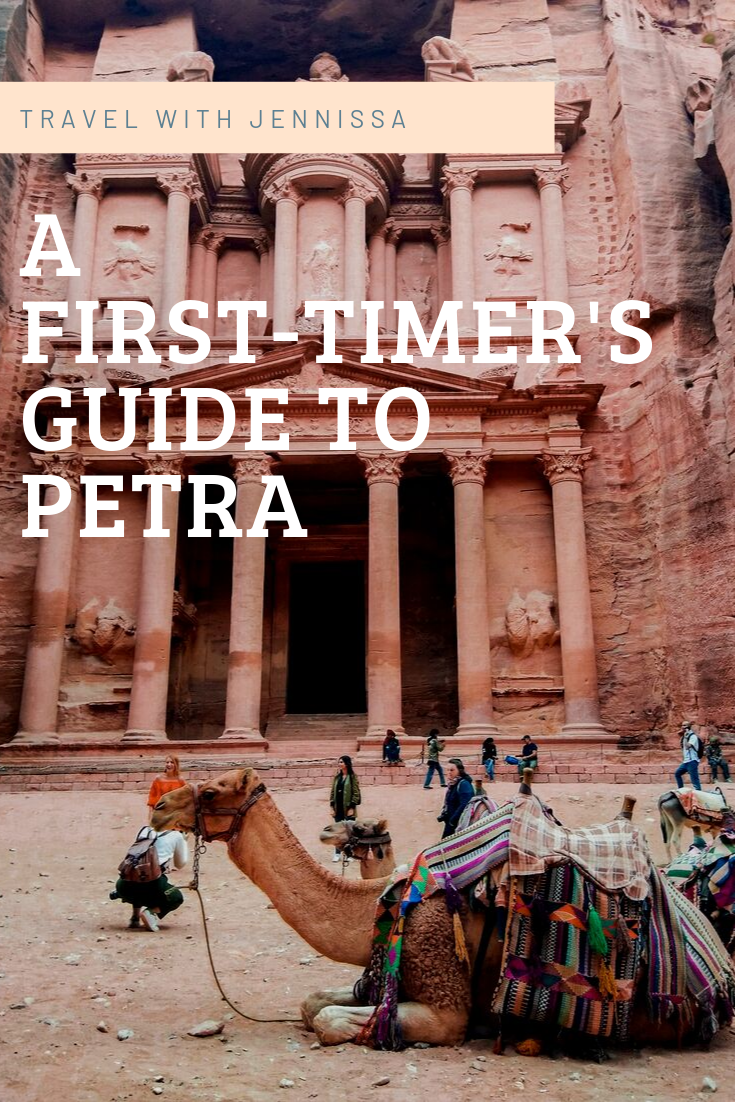Sandstone of red and pink hues, monuments carved right into rocks. The abandoned city of Petra presents a facade unlike none other.
Displaying a remarkable and one-of-a-kind landscape, the ‘Rose City’ has undoubtedly found its name on prominent lists such as the UNESCO World Heritage Sites, the Seven Wonders of the World and Places To See Before You Die.
Today, the ‘Lost City’ is an archaeological marvel with a rich cultural history that attracts millions from across the globe. So let’s up brush up on some exciting facts and pro tips about Petra.

1. What is Petra?
Here’s Petra’s history in a nutshell: Way back in the day, around the 6th century BC, Petra was the capital of the Nabataean (nomadic tribe from Arabia) kingdom. In 106 AD, the Romans captured it and further expanded the city. In 663 AD, an earthquake destroyed the buildings and the water management systems. Thus, Petra was left abandoned until 1812, when a Swiss explorer discovered the ‘Lost City’.
At present, Petra is one of the Seven Wonders of the World and on the bucketlist of travellers from far and wide.

2. How to get to Petra?
You can fly into Jordan from either the Queen Alia Airport at Amman or the King Hussein International Airport at Aqaba.
Petra is an easy drive from Amman via both the Desert Highway as well as the King’s Highway. While the former route is a quick 3 hour drive, the latter is a 4.5 hour long but picturesque journey. Aqaba is a 2 hour drive from Petra.
Want to save yourself from the driving? You can fall back on public transport to get you to and from Petra.
From Amman : The JETT Bus leaves from Abdali Station (Amman) at 6:30am and the return bus starts from Petra at 5:00pm. While a one-way bus ticket costs 11 JD, taxi fares could reach a whopping 85 JD.
From Aqaba : The JETT Bus departs from Aqaba at 8:30am and returns back to Aqaba at 4:00pm. A one-way ticket costs 12 JD whereas a return ticket costs 20 JD. Taxi fares are exorbitantly priced at 60 JD.
Wadi Musa, the nearest town, is a 20 minute walk away from Petra. Hotels here run free shuttle services to Petra too.
Another hassle-free way of getting to Petra is by booking an organized tour which includes transportation as well as a few meals.
Also read : How to Explore Amman, Jordan in Just One Day
3. When is the best time to visit Petra?
Remember that Petra is located in a desert and also at a high elevation. So summers could get unbearably hot and winters can be very cold.
Thus, spring (March through May) or autumn (September through November) seasons are your safest bets.
4. What are the opening timings?
Petra is open to visitors from 6:00 a.m. to 6:00 p.m. during the summer season and 6:00 a.m. to 4:00 p.m. in the winters.
On Mondays, Wednesdays and Thursdays, Petra is open from 8:30 p.m. to 10:30 p.m. for Petra by Night.
5. How much is the entrance fee?
1 Day Visitors to Jordan : 90 JD
1 Day : 50 JD
2 Days : 55 JD
3 Days : 60 JD
Petra by Night : 17 JD
Children under 12 : Free
Jordanians, students with a Jordanian University ID : 1 JD
Understanding the Entry Fee System :
The entry fee into Petra varies from those who stay overnight (including cruise visitors) to those who visit Jordan for a single day.
If you visit Petra on your first day in Jordan, it will cost you 90 JD since you haven’t spent the night in the country. But once you stay overnight in Jordan and return to Petra the next day, you get a refund of 40 JD. Weird, I know.
Proof for Overnight Visitors :
Passport along with date of entry into Jordan.
6. How much time is needed to explore Petra?
While this is subjective to each person’s curiosity and interest levels, your visit could take up simply one day or be stretched for as much as three days. But one entire day must be dedicated for exploring Petra.
Make sure to reach early, by dawn specifically, and stay until you watch it get lit up for Petra by Night. Petra might be known as the ‘Rose City’, but watch that same pink sandstone magically change colours as the sun rises and sets. It’s a sight you wouldn’t want to miss!

7. What’s there to see in Petra?
Bab As-Siq
This is where your Petra experience begins. The Bab As-Siq (Gate of the Siq) is the path that begins at the Visitor Center and ends at the Siq. Monuments and tombs, such as the Obelisk Tomb and the Djinn Blocks built by the Nabataeans can be seen along this walkway.

Siq
The entrance into the city of Petra is a winner by itself. Known as the Siq, this narrow gorge runs for 1.2 kilometers and dramatically opens up to most-photographed monument of Petra – The Treasury.
Walking here is a unique experience altogether. As you are sandwiched between towering rose-red cliffs and blindly follow the winding paths, your inquisitive mind can’t help but think, what more lies ahead?

The Treasury
As you near the end of the Siq, a large, rock-cut structure comes into sight. The Al-Khazneh (Arabic for Treasury), built in the 1st century BC, stands 40 metres tall with a purpose unknown. Some believe that it was a temple, others say that it was used to store documents, while a few theories suggest that it was the tomb of a Nabataean King. Thus, you can still say that Petra is a city of mysteries.
Situated on the second level, above the entrance of the Treasury, is an urn made of solid stone which is believed to have guarded a Pharaoh’s treasure. In order to plunder these riches, the Bedouins shot bullets at it, and if you look closely, the marks are still visible today.

The Theatre
Similar in design to any other Roman theatre, but the only difference was its style of execution. While a typical Roman theatre is built up, this theatre was instead carved out of the rocks.
Royal Tombs
All Nabataean monuments were carved into rocks, and so were the tombs of the Nabataean royalty. These tombs are collectively known as the Royal Tombs, thanks to their size and decoration. The four most-recognized tombs are the Urn Tomb, the Silk Tomb, the Corinthian Tomb and the Palace Tomb.
The Monastery
Another unmissable spot. Petra’s next most iconic structure, after the Treasury. The Ad Deir (The Monastery), built in the 3rd century BC as a Nabataean tomb, too has a rock-cut exterior and stands 45 metres tall.
Getting to the Monastery is a real task as it involves climbing 800 steps for around one and a half hours.
This Nabataean tomb was later called ‘The Monastery’ as the crosses inscribed on the walls suggests that it might have been used as a church during the Byzantine period.


8. What is Petra by Night?
As the sun sets and Petra gets dark, over 1,500 candles are lit up along the Siq and in front of the Treasury. If you have made it all the way to Petra, this night show is absolutely worth seeing!
Petra by Night runs thrice a week – Mondays, Wednesdays and Thursdays, from 8:30 p.m. to 10:30 p.m. The walk begins from the Petra Visitor Center, all through the Siq and ends at the Treasury. Take into account that your walk to the Treasury is more or less going to be spent in darkness along with a few candlelights guiding you. However, that simply makes the experience even more magical (and shouldn’t be considered as a drawback).
Petra by Night tickets cost 17JD, and it is not included in your regular Petra tickets.
9. Are there restaurants in Petra?
Yes, there are a few restaurants in Petra, but expensive ones. The Basin, one of the most famous restaurants in Petra, serves a buffet lunch for 20 JD.
An alternative is to carry packed lunch, usually given by some hotels if asked earlier.
Snacks and drinks are also sold at the stalls outside the entrance.
You might also like : A Guide to the Significant Churches in the Holy Land
10. How much does a horse/camel/donkey ride cost?
A horse ride from the Visitor Center to the Treasury is free of cost, but the tips are hefty. Hence, it is highly advisable to negotiate on the amount prior to your ride or simply walk it down.

A two-way horse and carriage ride from the entrance to the Treasury costs 20 JD. Furthermore, with prior bookings you can get a ride from the Visitor Center to the Basin Restaurant for 40 JD.
Donkey and camel rides are available from the Treasury to the Monastery, but there are no fixed prices so don’t get tricked into paying extra. Bargain! Bargain! Bargain! Do not pay more than 25 JD. Prices between 15-20 JD are an ideal amount.
Pro tip : While it’s easy to fall back on these animals to take you around Petra, try to avoid it. Mistreatment by the owners is prevalent in large numbers. As tourists, it is crucial to be stern with the riders if you witness any cruelty towards the animals.
11. What to wear in Petra?
Comfortable walking shoes! No matter what you are dressed in, it is imperative to wear a sturdy pair of walking shoes considering that Petra is all about walking and hiking for hours and hours together.
Petra is mainly flooded by tourists, so you are open to a number of clothing options, but it is preferable to avoid shorts and sleeveless tops. I wore a pair of culottes, a T-shirt and a denim jacket.

Sunglasses, a hat or a scarf, and an extra layer to keep you warm in the evening are other important must-haves while visiting Petra.
12. Is Petra safe?
Yes, Petra is a safe place to visit. Locals here solely depend on tourism for their economic stability. Thus, tourist safety is of utmost importance to them. Moreover, Petra is one of Jordan’s prime tourist spots. Keeping this is mind, the Jordanian government has ensured safety of the site with a large security presence.
I hope this guide has more or less answered your questions about Petra! So are you ready to explore Petra like a pro? Let me know about your thoughts in the comments section below!


Enjoyed reading this post? I’d be very grateful if you’d share it with your friends and family! Thank you!




Leave a comment